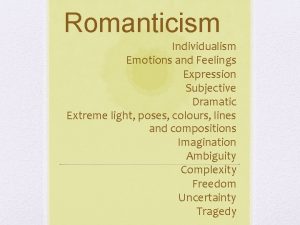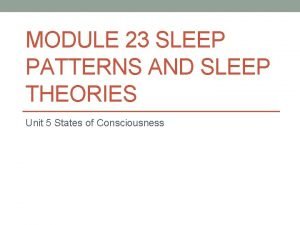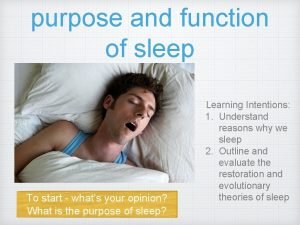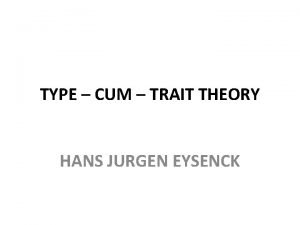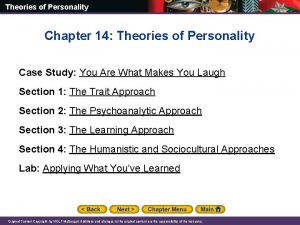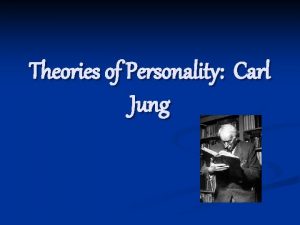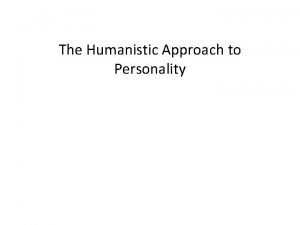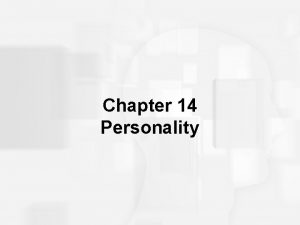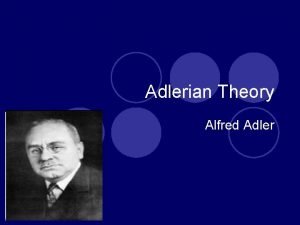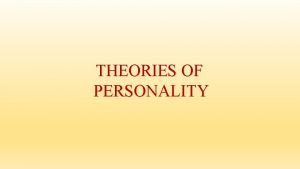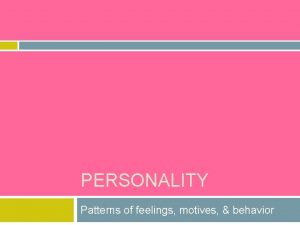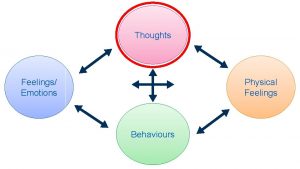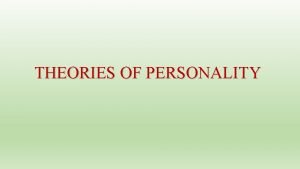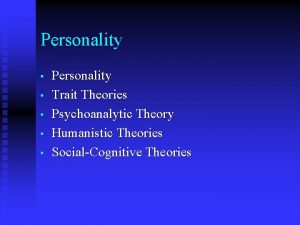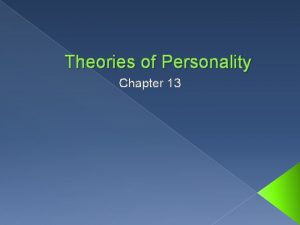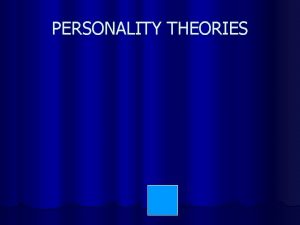Personality Theories Personality patterns of feelings motives and













- Slides: 13

Personality Theories

Personality patterns of feelings, motives, and behavior that set people apart from one another

Humanistic Theory People are free to do as they choose and are responsible for the choices that they make Abraham Maslow We desire to achieve self-actualization Self-actualization = Reaching one’s full potential Carl Rogers Self-Theory Self-concept = a view of oneself as an individual Congruence = consistency between one’s self concept and one’s experiences

Sociocultural Theory Focuses on three factors Ethnicity Gender Culture Key factors in our personality are our family and environmental influences

Learning Theory Emphasizes the effects of experience on behavior Behaviorism John B. Watson Claimed that external or environmental forces shape people’s preferences and behaviors B. F. Skinner emphasized the effects of reinforcement on behavior Social Learning Theory Albert Bandura Focus on the following factors: the importance of learning by observation the role of the cognitive processes

Psychoanalytic Theory Believes how we behave is a result of our unconscious Unconscious=impulses/needs unknown to us Includes sexual and aggressive urges We struggle to choose between our biological drives (instincts) and social rules (expectations of society) This struggle leads to “inner conflict”

Freud’s Psychological Structures of the Mind Id Pleasure principle Includes instincts (hunger) Wants instant gratification Pays no attention to rules, laws, consequences All unconscious

Freud’s Psychological Structures of the Mind Superego Moral principle Incorporates expectations of society Acts as the conscience (morals) Both conscious and unconscious

Freud’s Psychological Structures of the Mind Ego Reality principle Understands we cannot always get what we want Uses reason and good sense Tries to balance the id and superego Mostly conscious, part unconscious


Psychoanalytic Theory Defense Mechanisms Used by the ego Avoid recognizing ideas/emotions that cause anxiety Use them unconsciously

Trait Theory : Big 5 Trait = an aspect of personality that is considered to be fixed/unchanging Traits are like building blocks – how they stack up impacts our personality

NOT USING THIS SLIDE!! Psychoanalytic Theory Freud believed you could access unconscious thoughts in the following ways: Free association: the uncensored uttering of any thoughts that come to mind Dream analysis: Our unconscious thoughts are disguised in our dreams Hypnosis: Hypnotic state allowed access to our unconscious
 Feelings feelings feelings
Feelings feelings feelings The patterns of feelings motives and behavior
The patterns of feelings motives and behavior Module 23 sleep patterns and sleep theories
Module 23 sleep patterns and sleep theories Module 23 sleep patterns and sleep theories
Module 23 sleep patterns and sleep theories Module 23 sleep patterns and sleep theories
Module 23 sleep patterns and sleep theories Trait theory hans eysenck
Trait theory hans eysenck Associations and correlations in data mining
Associations and correlations in data mining What does the psychoanalytic approach to personality teach?
What does the psychoanalytic approach to personality teach? Carl jung personality
Carl jung personality Humanistic personality test
Humanistic personality test Theories of personality quiz
Theories of personality quiz Freudian theory of personality in consumer behaviour
Freudian theory of personality in consumer behaviour Adlerian counseling strengths and weaknesses
Adlerian counseling strengths and weaknesses Eysenck dimensions of personality
Eysenck dimensions of personality
